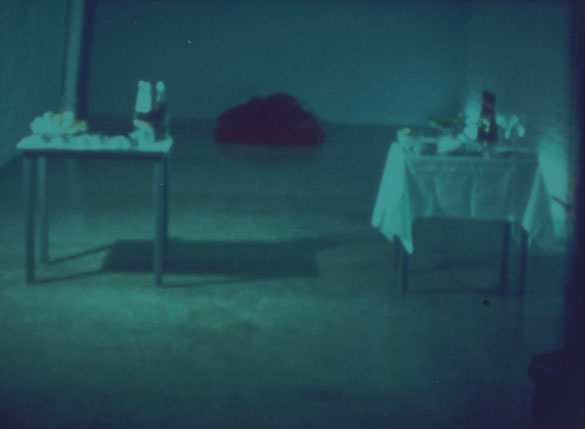Happy Birthday to Marina Abramović and Ulay

Thirty-two years ago today, the performance artists Marina Abramović and Ulay celebrated their shared birthday by creating a beautiful and little-known performance work, Communist Body / Fascist Body. This work is one of the centerpieces of Feast, so today is the perfect moment to introduce it to you.
(It's also a great moment to mention that we're partnering with the Chicago Humanities Festival to bring Marina in to give a lecture on February 16, 2012. She's one of the most brilliant -- and occasionally controversial -- artists of our time.)
Communist Body / Fascist Body is part of a rich body of collaborative work produced by Abramović and Ulay. They collaborated for over a decade, beginning in the mid-1970s when Abramović moved to Amsterdam from her native Serbia (then Yugoslavia). Partners in both art and love, they used their own bodies and psyches as primary material for their art.
Many of their works took the form of pared-down actions that extend to physical and mental extremes. In Breathing in, Breathing Out (1977), for instance, they locked lips, breathing in the stale air from each other's exhalation, pushing to the edge of physical collapse. Simple in structure, their performances were often meant to engage the audience's response on an emotional--even primal--level while also evoking heady topics like the boundaries of self, the limits of the body, and the power dynamics inherent to any interpersonal relationship. The pair famously ended their collaboration with the performance The Lovers: The Great Wall Walk (1988) in which they walked from opposite ends of the Great Wall of China, meeting briefly in the middle as the final moment in their collaborative practice.
Abramović and Ulay's original performance of Communist Body / Fascist Body took place one evening in 1979, when the artists invited a small group of friends to come to at their Amsterdam apartment just before midnight on their shared birthday. The unsuspecting guests arrived to discover a tableau arranged by the artists -- two tables, one beautifully set with silver, crystal, German champagne, white bread, and caviar, the other set with cheap Russian versions of the same (e.g. toilet paper rather than damask napkin). Their birth certificates were displayed on a third table. In the back of the space, the Abramović and Ulay lay on a low mattress, under a red blanket, apparently asleep.
Communist Body / Fascist Body feels like one of the real finds of the exhibition. It's a rich and moving work and one that should be much better known than it is. I first came across references to the piece last year while researching Feast, and found descriptions of the performance fascinating especially in terms of the complex relationships that it established among the participants.
The tableau contrasted the fact of the quietly sleeping, united couple with a geopolitical opposition that foregrounded their roles as separate beings, whose selves were shaped by everything they ingested growing up in different nations, ideologies ,and economies. It also upended the usual kinds of interaction between host and guest. The hosts were present -- physically there -- but also absent -- asleep (or performing sleep) and so not attending to any of the host's usual duties of welcome or attention. The guests responded in different ways to this surreal repast -- some were disturbed, others relaxed and convivial -- but eventually they embraced the situation, popped the champagne, and enjoyed the party.
We know about the guests' richly varied reactions because Abramović and Ulay wove documentation into the fabric of the performance: a friend filmed the evening, and then edited that footage together with audio interviews that they conducted with their guests a few weeks later. They completed the loop by screening the resulting film to their guests in the same space in which the performance occurred, three months later.
So, although Abramović and Ulay established the original work as a closed circuit, they always meant for it to have a life for an audience beyond that initial circle of participants. Until now, the work has only been shown rarely, as a film. On the occasion of Feast, Abramović and Ulay have decided to embrace the issue of re-performance in a new way by creating a fresh version of this work: an installation that recreates the original setup (tables, bread, and champagne, bed) with the original video projected in the space as a way of anchoring and vivifying the video's evocation of that original meal.
The Smart is thrilled to be collaborating with the artists to produce this new version of the work. And it's personally deeply moving to me as a curator to see how much it means to the artists to be revisiting this work, after so many years, together.
Above: Marina Abramović and Ulay, Communist Body / Fascist Body, Performance, Zoutkeetsgracht 116 / 118, Amsterdam, November 30, 1979. Courtesy of the Marina Abramović Archives. © Marina Abramović.